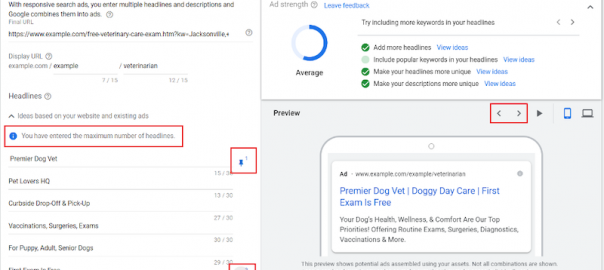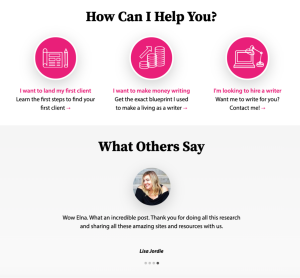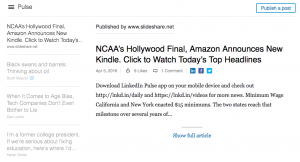Back in March when Google replaced expanded text ads (ETAs) with responsive search ads (RSAs) as the default ad type for Search campaigns, we all had a feeling that ETAs might be on their way out.
And sure enough, on August 31, Google announced that it is sunsetting ETAs as of June 30, 2022.
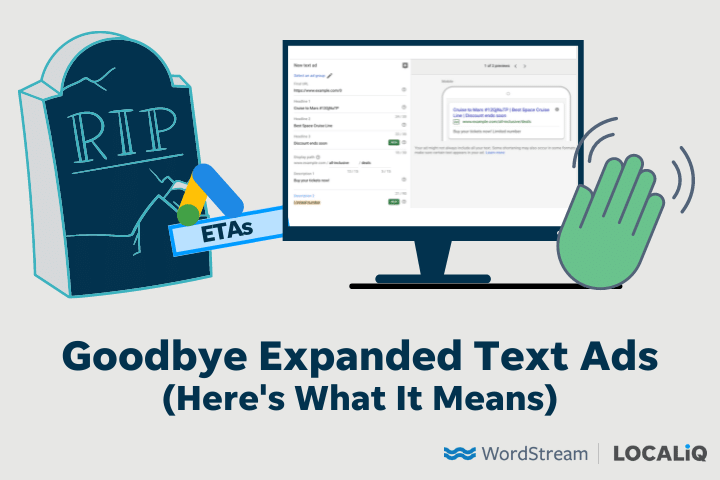
Reactions to this announcement are mixed. While no one is excited about the change, advertisers are expressing varying levels of discontent and concern—in some cases due to personal experience, and in others due to level of awareness.
So to help you make sense of it all, I took a dive into what’s going on and had my teammate and PPC expert Susie Marino weigh in on the points of concern.
So read on to learn:
- How and when Google is sunsetting ETAS.
- What you should (and shouldn’t) be concerned about.
- What you can do to stay successful with your paid search strategy.
Thank you, Susie, for sharing your expertise!
What’s happening to ETAs: the facts
On August 31, Google announced that as of June 30, 2022, responsive search ads (RSAs) “will be the only Search ad type that can be created or edited in standard Search campaigns.”
What this means
Your existing expanded text ads (ETAs) will continue to run and you’ll be able to report on their performance, but you’ll only be able to pause, resume, or remove them—not edit or create new ones.
Why retire ETAs?
Google’s position behind the change is as follows:
- With 15% of search queries per day being new, “automation is the key to keeping pace with these trends.
- Its solution, RSAs, “help you compete in a wider variety of relevant auctions” and “drive incremental conversions [with] fewer ads.”
Potential reasons to be concerned about RSAs
As has been the case with most of Google’s announcements over the past 18 months, the overall sentiment is:

There is also a tweet involving excessive amounts of vomit but we’ll let you find that one on your own.
But let’s take a closer look at the particular conditions for some of these concerns so you can determine how much—or how little—the change may impact your account.
Difficulties with ad copy
Many advertisers like ETAs because it grants them more control over their ad copy, so the switch to RSAs causes many to feel like Google is taking full control.

It’s more about context and ease
“This is true to some degree, says Susie. “Google isn’t necessarily taking control of the copy, but more so taking control of the order of the copy—which can completely change the context of the ad, sure.
I feel like advertisers won’t miss the lack of control as much as they’ll miss the ease of creating text ads and sticking to them. Advertisers that struggle with coming up with three headlines and two descriptions are going to have a hell of a lot harder time when it comes to 15 headlines and four descriptions.”
And the issue with RSA’s isn’t always even the lack of control over the order. Sometimes, there’s just only so many different ways you can say “buy our insurance” or “call us for a consultation.”
Pinning workarounds have their limitations
Another concern about this change is for businesses in highly regulated industries, like pharma, credit unions, franchises, and legal. Pete Bowen talks about this in his tweet about “legal in some states where you have to submit (and pay) for state bar approval for every version of the ad.”
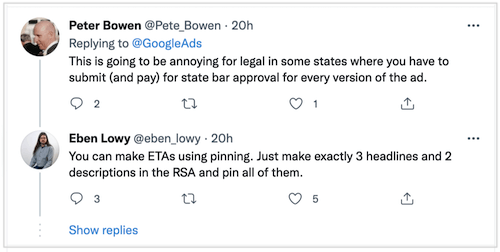
Workaround #1: Pin them all
As you can see, Eben Lowy provides a smart workaround here: “You can make ETAs using pinning. Just make exactly three headlines and two descriptions in the RSA and pin all of them.”
“This is actually a really smart solution,” says Susie. “Not recommended because it defeats the purpose of RSAs so I wouldn’t be surprised if Google blocks the ability to use all the pins down the line, but this could work.”
Workaround #2: Pin some, leave the rest blank
Susie suggests another workaround where you’d only fill out three headlines and two descriptions and leave the rest of the RSA blank like an ETA. “BUT,” she warns, “Google picks up on ad strength in both those workaround scenarios so doing this could maybe hurt your Quality Score or ad rank. “
Ebony acknowledges this in the above thread, and we see more tweets on this concern elsewhere:
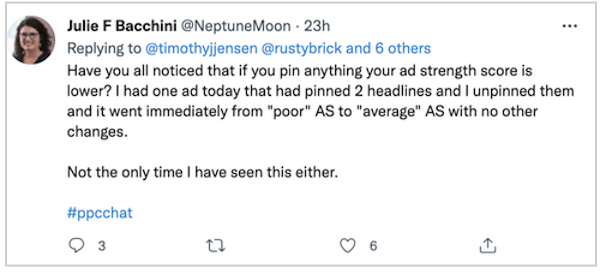
Then again, Quality Score is of varying importance to advertisers these days.
RSA reporting isn’t great
Another concern advertisers have is with reporting. Reporting allows us to test and optimize, and the point of RSAs is to build testing into the campaign and let Google take care of that for you. The idea is for you to save time in Google Ads while Google serves up more relevant headlines to its searchers.
But as Chris Ridley says in his tweet below, “We can’t base ad copy optimisations solely on how much Google likes to show a specific combination.”
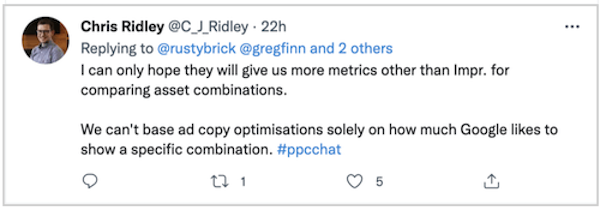
This is a valid point. But some advertisers are asking for the ability to report on every version of the ad.
Improved reporting? Yes. In-depth? Probably not worth it.
“So reporting on RSAs exists and is fairly helpful, but yes, it is VERY high-level reporting. But with 15 headlines and four descriptions, there’s thousands of combinations, so as much as the industry may want in-depth reporting on each one, no one in their right mind would actually bother with that. Maybe for top performers, but this could be coming down the line.”
Google has a great resource on reporting for RSA combos that I use all the time, and it’s awesome.”
Make it usable
Greg Finn shares the same perspective. “Stinks for anyone in highly regulated fields. Would be nice if the RSA data was usable or scientific instead of a generic ‘Best’ or ‘Good’ & knowing combos that work together would help.”

Reasons not to panic about the departure of ETAs
So first and foremost, this should come as no surprise.
Susie speaks for most advertisers when she says, “We saw this coming from a mile away when Google announced RSA’s were the ‘default ad type’ for Search campaigns back in March 2021, then made users jump through hoops to get to the ETA creation portal.”
Navah Hopkins says something similar on LinkedIn: “Am I surprised? Not at all – they’ve been hidden for net new ad accounts for some time and almost always lose out to RSAs on impressions.”
So maybe you’re not surprised, but you are still worried. Here are some helpful reminders and suggestions.
1. Automation is getting better
Many are up in arms about this just being another step in Google’s push for automation, but take these perspectives into consideration.
Automation isn’t evil
In the same LinkedIn post mentioned above, Navah Hopkins writes:
“Am I concerned? Not really! Google Ads has done a really good job of improving the ad format and allowing us to simulate the brand integrity of ETAs while benefitting from built-in A/B testing.”
Sometimes RSAs perform better
And Susie feels the same way. “In my experience, I’ve often seen RSA actually have performed better than the ETAs. Not always, but usually. Maybe that’s because Google has been secretly favoring them and ranking them higher all along. Who knows. But this definitely matches Google’s overall push for automation and trust in its algorithm. I’ll give them credit that their machine learning has gotten better over the years (which is probably why they’re deciding to do this now). But they still have a long way to go.”
But not always
However, not all advertisers have had this experience.
In Search Engine Land’s coverage on the issue, Carolyn Lyden shares a different point of view:
“‘RSAs underperform ETAs almost universally in my experience,’ said Collin Slattery, Founder Taikun Digital. “RSAs almost always under-perform ETAs, across millions in spend and over a year of testing. It’s not close, either,’ agreed Sam Tomlinson of EVP Warschawski.”
But it’s here to stay
“Either way,” Susie says, “as much as we hate to admit, automation is the inevitable future of advertising.”
2. ETAs aren’t just for Google Ads
Susie reminds us:
“Let’s also not forget there’s another platform that still includes ETA’s. What was their name again? Oh yeah, Microsoft Advertising. Microsoft Ads have held their own as a great alternative to Google for advertisers who want to maintain control.”
It’s almost like when you ask one parent something and they say no, so you go to the other. There’s plenty of fish in the advertising sea.“
We talk about Microsoft expanded text ads here, and actually once found that Microsoft ETAs outperformed Google’s.
3. You still have some control
As we touched on above, the ability to pin still gives you some control.

Just don’t over-pin
“I really think pinning will be our savior here,” says Susie. “Remember, though, Google will knock your ad strength when you pin a ton. Plus, they even have a little blurb about how overpinning isn’t recommended:
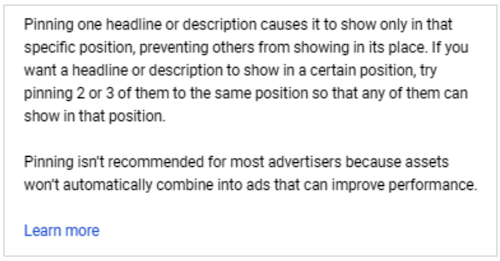
“However, pinning is the closest thing we have to maintaining control. I swear, though, if everyone overuses it to the point where they take that away too, I’m coming for all you guys!”
4. Ad customizers (and DKI) aren’t leaving
There are many advertisers asking whether ad customizers will also be retired, but what they don’t realize is that ad customizers have always been available for RSAs (however, not globally) as well as Dynamic Keyword Insertion.
5. We have time
On a lighter note, Kirk Williams gives Google props for potentially the “longest notice we’ve EVER received on a major Google Ads change.”
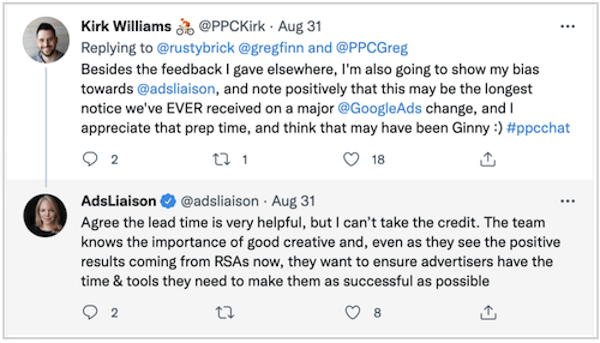
And Steve Plimmer points out in his tweet that hopefully between now and the next 10 months, Google will allow us to see useful insights.

So, what should you do? Tips for ETAs & RSAs
As we just covered, we have time here. So here are our recommendations
1. Create and test ETAs
Susie tells us to “Take a breather here and remember your ETAs can still run—you just can’t change them. So A/B test your ETAs all you want before then and keep the best one as is for as long as you can.”
But don’t obsess over ETA copy
In this day and age, if you’re wasting time fiddling with ETA ad copy, you have your PPC priorities in the wrong place. Plus, there’s so many other things we can control, like targeting and more.
I think people often overcomplicate PPC to try to find the answers or results they want to see that just aren’t going to come, which I can understand because you’re putting your money towards it. But, honestly, changing the headline in your ETA isn’t going to make or break your account regardless.”
Create evergreen ETAs
In her Search Engine Journal coverage on the matter, Amy Bishop has similar advice:
“I would absolutely suggest testing ETAs hard in the next few months while you can still create them. Be sure to add some evergreen ETAs that you can use in the future, as well. You may even want to set up some additional ads so that you can continue testing even after you’re unable to add new ETAs.”
2. Get familiar with RSAs
Susie provides plenty of tips and strategies for RSAs here, but here is the gist:
- Refresh your ad copy regularly so viewers have something new to look at.
- Leverage Dynamic Keyword Insertion and ad extensions.
- Take advantage of the shuffled previews Google provides.
- Make sure all combinations will work together.
- Use pinning.
- Use the Ad strength tool
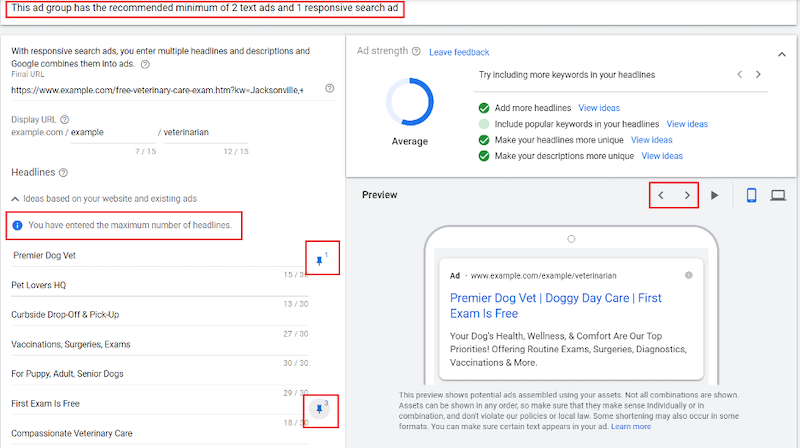
3. Don’t forget about call ads
Susie reminds us that call-only ads are another option for running Search campaigns:
“Call ads are popular for lots of industries like legal, medical, food, and small businesses. And what’s set is set. So if you don’t want to use RSAs or ETAs or anything dynamic, I’d definitely suggest using those.
AND! Google recently updated these so you get an extra headline on top of number, business name, and two descriptions.”
Accept, adapt, and await
“All in all,” Susie says, “Are we surprised? No. Is it a big deal? Yes. Some will benefit from it, others will struggle, and there are workarounds and options.”
For now, that is. So I will leave you with three tips:
- Accept: Regardless of how much this will impact your Google Ads performance, we can’t change Google’s mind, so acceptance is the best way forward.
- Adapt: Get familiar with RSAs if you haven’t already, start pumpin’ out ETAs like there’s no tomorrow, and take advantage of pinning capabilities and call-only ads.
- Await: Hopefully, Google Ads will introduce some new features to help with reporting and other concerns, so stay abreast of new announcements and platform updates.
Digital & Social Articles on Business 2 Community
(54)
Report Post